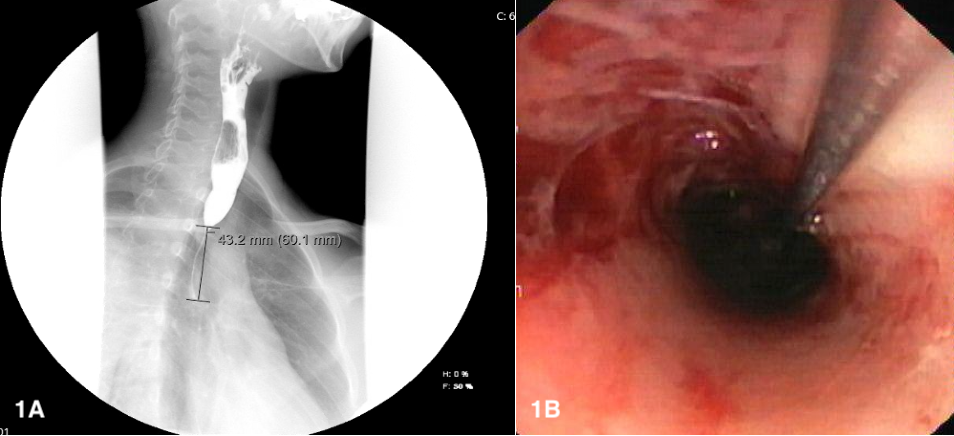Sunday Poster Session
Category: Esophagus
P0707 - Dysphagia Secondary to Esophageal Strictures in a Patient With Epidermolysis Bullosa Simplex: A Case Report
Sunday, October 26, 2025
3:30 PM - 7:00 PM PDT
Location: Exhibit Hall
- HA
Hend Almuhaya, MBBS
King Faisal Specialist Hospital and Research Centre
Riyadh, Ar Riyad, Saudi Arabia
Presenting Author(s)
Hend Almuhaya, MBBS, Asma Alnajjar, MBBS, Bader Alajlan,
King Faisal Specialist Hospital and Research Centre, Riyadh, Ar Riyad, Saudi Arabia
Introduction: Epidermolysis bullosa (EB) is an inherited, uncommon disorder characterized by skin and mucosal fragility. The gastrointestinal tract (GIT) is a major location of extracutaneous damage in hereditary EB. Epidermolysis bullosa simplex (EBS) is the subtype least associated with GIT involvement, causing dysphagia in 2% of cases and having the lowest cumulative risk of esophageal stenosis.
Case Description/
Methods: An 18-year-old man with a past medical history of EBS diagnosed at the age of 10, was referred for progressive dysphagia over the past year, mainly with solids. He denied food impaction, choking, or odynophagia. He was underweight, with a body mass index (BMI) of 14. Skin exam revealed crusted erosions and atrophic scars, mainly on the extremities. Laboratory results were unremarkable. Barium swallow revealed a 4 cm stricture at the upper to mid-esophagus junction with proximal dilation (Figure 1A).The patient underwent 10 endoscopic dilatation sessions over the past three years using Savary-Gilliard dilators and was maintained on a twice daily proton pump inhibitor and sucralfate. Initial esophagogastroduodenoscopy (EGD) in our hospital revealed diffuse sloughing esophagitis, and a severe stricture measuring 2 cm in length and 6 mm in diameter was noted at 20 cm from the incisors. Another stricture, 2 cm in length and 4 mm in diameter, was seen at 30 cm which could not be traversed with a pediatric scope. Dilatation with Savary dilators was performed, starting with 6 mm and increased up to 9 mm. Biopsies showed severe acute esophagitis with ulceration and granulation tissue, without eosinophilia. Following multiple sessions, the esophageal diameter increased to 15 mm, resulting in symptom relief that lasted up to four months (Figure 1B).
Discussion: EB is a rare inherited disorder, with the esophagus being the most affected GIT organ. EBS is the most prevalent subtype of EB and rarely involves the GIT. Only a few cases of EBS-related esophageal stenosis have been reported. There is no definitive cure for esophageal stenosis associated with EBS; however, esophageal dilatation is an effective intervention for managing esophageal strictures among patients with EB, potentially alleviating dysphagia and food intake issues.

Figure: Figure 1A: Barium study revealed a 4 cm stricture with proximal dilation.
Figure 1B: Post-dilatation esophageal stricture
Disclosures:
Hend Almuhaya indicated no relevant financial relationships.
Asma Alnajjar indicated no relevant financial relationships.
Bader Alajlan indicated no relevant financial relationships.
Hend Almuhaya, MBBS, Asma Alnajjar, MBBS, Bader Alajlan, . P0707 - Dysphagia Secondary to Esophageal Strictures in a Patient With Epidermolysis Bullosa Simplex: A Case Report, ACG 2025 Annual Scientific Meeting Abstracts. Phoenix, AZ: American College of Gastroenterology.
King Faisal Specialist Hospital and Research Centre, Riyadh, Ar Riyad, Saudi Arabia
Introduction: Epidermolysis bullosa (EB) is an inherited, uncommon disorder characterized by skin and mucosal fragility. The gastrointestinal tract (GIT) is a major location of extracutaneous damage in hereditary EB. Epidermolysis bullosa simplex (EBS) is the subtype least associated with GIT involvement, causing dysphagia in 2% of cases and having the lowest cumulative risk of esophageal stenosis.
Case Description/
Methods: An 18-year-old man with a past medical history of EBS diagnosed at the age of 10, was referred for progressive dysphagia over the past year, mainly with solids. He denied food impaction, choking, or odynophagia. He was underweight, with a body mass index (BMI) of 14. Skin exam revealed crusted erosions and atrophic scars, mainly on the extremities. Laboratory results were unremarkable. Barium swallow revealed a 4 cm stricture at the upper to mid-esophagus junction with proximal dilation (Figure 1A).The patient underwent 10 endoscopic dilatation sessions over the past three years using Savary-Gilliard dilators and was maintained on a twice daily proton pump inhibitor and sucralfate. Initial esophagogastroduodenoscopy (EGD) in our hospital revealed diffuse sloughing esophagitis, and a severe stricture measuring 2 cm in length and 6 mm in diameter was noted at 20 cm from the incisors. Another stricture, 2 cm in length and 4 mm in diameter, was seen at 30 cm which could not be traversed with a pediatric scope. Dilatation with Savary dilators was performed, starting with 6 mm and increased up to 9 mm. Biopsies showed severe acute esophagitis with ulceration and granulation tissue, without eosinophilia. Following multiple sessions, the esophageal diameter increased to 15 mm, resulting in symptom relief that lasted up to four months (Figure 1B).
Discussion: EB is a rare inherited disorder, with the esophagus being the most affected GIT organ. EBS is the most prevalent subtype of EB and rarely involves the GIT. Only a few cases of EBS-related esophageal stenosis have been reported. There is no definitive cure for esophageal stenosis associated with EBS; however, esophageal dilatation is an effective intervention for managing esophageal strictures among patients with EB, potentially alleviating dysphagia and food intake issues.

Figure: Figure 1A: Barium study revealed a 4 cm stricture with proximal dilation.
Figure 1B: Post-dilatation esophageal stricture
Disclosures:
Hend Almuhaya indicated no relevant financial relationships.
Asma Alnajjar indicated no relevant financial relationships.
Bader Alajlan indicated no relevant financial relationships.
Hend Almuhaya, MBBS, Asma Alnajjar, MBBS, Bader Alajlan, . P0707 - Dysphagia Secondary to Esophageal Strictures in a Patient With Epidermolysis Bullosa Simplex: A Case Report, ACG 2025 Annual Scientific Meeting Abstracts. Phoenix, AZ: American College of Gastroenterology.
